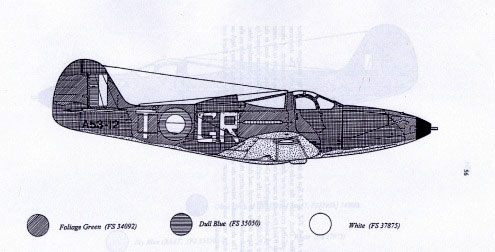|
S u m m a r y
|
| Title and Author |
The Modeller's Guide to the Bell
P-39 Airacobra In RAAF Service by Gary Byk. Published by Red Roo |
| ISBN: |
|
| Media: |
Soft cover, 94 pages plus covers,
colour and b&w photos |
| Price: |
AUD$18.50 |
| Review Type: |
First Read |
| Advantages: |
Inexpensive; good coverage of the
specific subject; helpful photos and colour chips; appealing to modellers
and historians |
| Disadvantages: |
|
| Recommendation: |
Highly Recommended |
Reviewed by Dallas Gavan

HyperScale is proudly supported by
Squadron.com
This book is number 4 in a series of aircraft monographs,
concentrating on aircraft that served with the Royal Australian Air Force
(RAAF), prepared by Red Roo Models. The series to date covers the Boston,
Buffalo, Kingfisher, Kiowa, Mustang, Mirage and a book on understanding
RAAF colour schemes.
The books are specifically written with both the modeller
and enthusiast in mind, covering not only the history of the aircraft, but
also tips for building the relevant models. Anyone interested in RAAF
aircraft of WWII, or the P-39 family of aircraft, should be interested in
this book. The book is available from Red Roo Models ( http://www.redroomodels.com
). The book sells for $18.50AUD and shipping is at cost.
History
The history of the P-39 is fairly well known. And it's
also dealt with, in detail, in the book- so I won't repeat it here.
Instead I'll give a quick overview of the aircraft's history in RAAF
service. Most Australians wouldn't know that the RAAF flew P-39's in WWII.
Loaned to the RAAF by the USAAF, at a time when Australia was desperate
for any sort of modern fighter, these aircraft never saw combat. Instead
they were allocated to squadrons tasked with patrolling around major
cities, protecting against Japanese intruders such as the one that
reconnoitred Sydney, prior to a midget submarine attack, in 1942.
Eventually the P39's were replaced by the more favoured P-40 and CAC
Boomerang. The surviving aircraft (some had been lost in crashes) were
returned to the USAAF.
Format
The book is in a soft-bound, A4 format and contains 94
pages. Each copy is individually numbered and signed by the author and the
book first appeared in 1997. Obviously the work of a "desk top publisher",
this is nevertheless a well-made and study addition to my library. While
it would be nice to see the book in hard-cover format, the probable cost
of such means I probably couldn't afford to buy it. By staying with the
desk-top publishing method, Red Roo have made the book available to anyone
who wants it, at a reasonable price.
Contents
The book is broken up into nine chapters and three
appendices. These cover:
-
The history of the aircraft,
-
US nomenclature and markings
-
Aircraft structure and
construction,
-
P-39 camouflage and markings in
RAAF service,
-
Building the available models,
-
A gallery and a folio of plans
and aircraft service cards.
The appendices cover the RAAF's general camouflage
instructions and fleet list, P-39D and -39F specifications and model
development and FS and BS numbers for matching (as closely as possible)
RAAF paints.
The P-39 has long been a source of debate among Australian aircraft
modellers. Colour schemes were poorly documented and with many aircraft
rushed into service after minimal preparation, the colours and patterns
that were used are open to all sorts of interpretations. Where there's
some debate on what colours an aircraft sported, Gary discusses the matter
and then (probably wisely) leaves the reader to decide.
The aircraft profiles given show a number of schemes- the common, early
Olive Drab over RAAF Sky Blue (the only undersurface colour used,
apparently) predominates. Others are Foliage Green and Earth Brown,
Foliage Green and Olive Drab and an aircraft that is Olive Drab and either
Medium Sea Grey or Dark Sea Grey camouflage. Some unusual schemes appear
before you start looking at the markings. 23 Squadron's aircraft, for
example, had a two letter code (squadron letter and aircraft letter)
painted on the nose.
Also included are colour chips for Foliage Green, Earth Brown and Sky
Blue, for those who want more than an approximate FS number to go by.
There's numerous scale plans and B&W photo's of the various P-39's in
service with the RAAF, as well as some shots of USAAF aircraft and some
useful shots of an aircraft undergoing restoration- showing plenty of
detail. Most of the photo's have well written, comprehensive captions
explaining possible colours of the aircraft, the markings and any unusual
features.

The chapter on the various models that have been made of the P-39 gives
details of shortcomings with the models, tips to improve them and also
looks at after-market accessories and decals. Produced before the
excellent Eduard kit hit the market, the book necessarily concentrates on
the Monogram 1/48 kit as well as the 1/72 scale offerings from Airfix,
Revell and Heller. Surprisingly neither Hasegawa nor Tamiya seem to have
kitted this aircraft in any scale.
Is the book worth the price? No doubt at all. If you're
looking for a scheme that's a little different from the usual USAAF or
USSR examples then you'll find plenty of material in this book. There are
early paint schemes, with blue and white upper wing markings but red,
white and blue markings elsewhere. Aircraft with two-letter codes on the
nose and others with the usual RAAF markings, but unusual camouflage, are
detailed. On a table full of "Air-a-Cuties", USAAF and USSR types, an OD,
foliage green and sky blue P-39F, with RAAF blue and white roundels, will
surely stand out.
Highly Recommended
Review Copyright © 2001 by
Dallas Gavan
This Page Created on 01 October, 2002
Last updated 22 July, 2003
Back to HyperScale
Main Page
Back to Reviews
Page
|
Home | What's
New | Features
| Gallery |
Reviews | Reference
| Forum
| Search